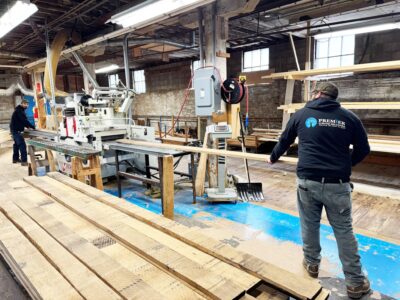
Guest Writer
With the release of “The State of Canada’s Forests – Annual Report 2023”, we have a chance to look at some of the trends and expected outlooks that the Canadian federal government is highlighting in the area of forests and wood products. This allows us to put in context some of the market comments and forecasts that the Ontario and Quebec manufacturers and wholesalers have been good enough to share with us over the last year. It also provides the latest statistics available for us to consider. Let’s have a look at what the report shows.
Canada is a forested country. It has 367 million hectares (ha) of forests, which is 15 times the size of all the Great Lakes combined. This is 9 percent of the world’s forest and about 25 percent of the world’s boreal forest. Seven percent of the forest are under private ownership. Over 90 percent of Canada’s forests are on public lands and about 45 percent of public land forests are managed for forestry. Almost 10 percent of the forest is legally protected with an additional 3 percent restricted for other reasons, including ecological reserves and traditional land use. While not entirely free of human activity, 30 percent of forest lands do not have formal management plans. Because of their size, biodiversity and contributions to carbon cycling, forests in Canada have global significance. Canada has been maintaining its forests, because since 1990 less than half of 1 percent has been deforested. Retaining its forest is vital and it should be noted that 72 percent of Crown forest land managed in Canada is certified to third-party standards for sustainable forest management (2022).
In 2022, the Canadian forest sector employed 212,660 people and their average earnings were approx. $51,900 annually (2022). In terms of employment, 19 percent of forest sector workers are women, 13 percent are immigrants, 12 percent are visible minorities and 6 percent are Indigenous. Over 1/3 of Canada’s total population lives in or near forests and enjoys the many benefits they offer – environmental, physical and cultural. The report notes that Canadians are feeling the effects of Climate change and no region of the country is immune.
In 2022, the forest sector contributed $33.4 billion (1.2 percent) to Canada’s nominal GDP, which represented a growth of 7 percent compared to 2021.
However, real GDP was flat year-over-year. Canada’s total economy increased by 17 percent in nominal terms and 3.6 percent in real terms during 2022. Wood product prices were quite high for much of 2022, and there were record highs for pulp prices. This helps explain the difference between the forest sector’s nominal and real GDP. The real GDP in the wood product manufacturing subsector went up 6 percent. This was a direct result of the continued high demand from the home building, repair and remodeling markets.
In the forestry and logging subsector, the real GDP fell 10 percent in 2022, driven by the on-going wood supply constraints in BC. Slowing residential construction activity continues to result in deteriorating affordability and worsening macroeconomic conditions. As such, demand for solid wood products is expected to decline further in 2023. A short-term slowdown is expected in the wood products sub-sector as housing starts and renovation spending have been negatively impacted by the high mortgage rates caused by the rising interest rates that central banks have implemented to combat inflation. In the longer-term, this sector’s prospects will be helped by underlying demand in the U.S. housing market.
In terms of exports, Softwood lumber and structural wood panels for home construction have been negatively impacted by inflation and related increased interest rates that central banks have implemented. The speed at which Canada’s main markets recover, particularly in the U.S., will determine how fast exports recover. In the longer term, forest product exports will continue to benefit from the strong underlying demand in the U.S. residential construction sector, which is our main market. Canada, by value is the 4th largest exporter of forest products in the world, behind China, Germany and the U.S. We are the world’s leading exporter of Softwood lumber, exporting $13.7 billion in 2022. High inflation, geopolitical uncertainty and the risk of economic recession may impact the financial performance and investment in the sector, in the short term. Again, in the long term, robust underlying demand for wood products will support the financial performance of the sector.
The secondary wood and paper product manufacturing industries in Canada generated $6.55 billion in real gross domestic product (GDP) in 2022. Growth in real GDP decelerated, edging up 0.4 percent over 2021. However, real GDP from forest sector secondary manufacturing has grown 11.4 percent since 2012. Secondary wood manufacturing was supported by strong domestic and export sales. Though the supply-chain has normalized post-COVID 19, there is significant uncertainty in the demand for secondary wood and paper products for 2023. Housing construction and the trends in online shopping and health and sanitation will have a big impact on demand.
Sustainable forest management aims to maintain and enhance the environmental, social and economic values of forests for the benefit of present and future generations of Canadians. It involves conserving biodiversity and protecting forest health, while ensuring the procurement of wood based products and ecosystem services. Canadian forests are managed under the paradigms and guiding principles of Canadian forest management. The forest sector is an important contributor to Canada’s economy, serving as a key source of prosperity.
Canada’s annual deforestation rate has slightly decreased over the last 3 decades. In 2021 51,000 ha of forests were converted to non-forest land uses, as compared to 64,000 in 1990, but Canada is responsible for only 0.37 percent of global deforestation that has occurred since 1990. The low annual area of recorded afforestation is much smaller than the annual area of deforestation, which in turn is much smaller than the total area of Canada’s forest. The outlook is for Canada’s deforestation rate to continue to remain steady at its current levels. Canada follows sustainable forest management principles for managing its forests. In 2021, approx. 698,000 ha of forests were harvested in Canada, which represents roughly 0.2 percent of forested land. Forest fires occurrence and spread vary significantly from year to year, but there are reasons why fires are becoming more damaging, not to mention more costly and difficult to control. There are more homes, businesses and infrastructure in the urban-wildland interface.
There are more people living and working in forested areas and visiting the forest for recreation. Years of successful fire suppression, insect damage and mortality means there is a buildup of forest fuel. More climate variability means more drought and high wind occurrence, which are ideal conditions for fire spread. The government is working on the detection and monitoring of fires and investing in improving emergency management.








